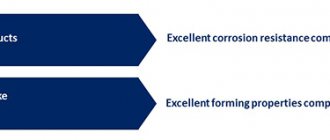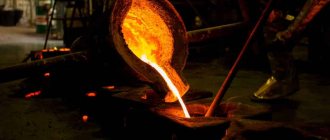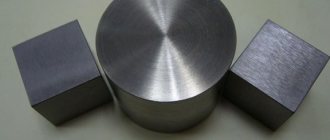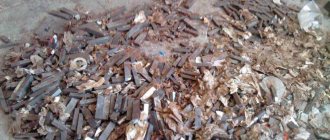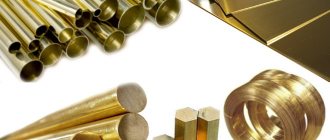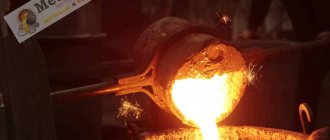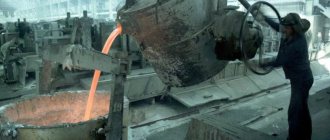Properties of alloys
The properties of metals and alloys are completely determined by their structure (crystalline phase structure and microstructure). The macroscopic properties of alloys are determined by the microstructure and always differ from the properties of their phases, which depend only on the crystal structure. Macroscopic homogeneity of multiphase (heterogeneous) alloys is achieved due to the uniform distribution of phases in the metal matrix. Alloys exhibit metallic properties, such as electrical and thermal conductivity, reflectivity (metallic luster) and ductility. The most important characteristic of alloys is weldability.
Distribution of alloys in modern industry
It should be noted that all metals that are intensively used by modern industry are alloys. Thus, more than 90% of all iron produced in the world is used for the production of cast iron and various steels. This approach to the matter is explained by the fact that metal alloys in most cases demonstrate better properties than their “progenitors”.
Thus, the yield strength of pure aluminum is only 35 MPa. But if you add 1.6% copper, magnesium and zinc to it in a ratio of 2.5% and 5.6%, respectively, then this figure can easily exceed even 500 MPa. Among other things, electrical conductivity, thermal conductivity, or other properties can be significantly improved. There is no mysticism in this: in alloys, the structure of the crystal lattice changes, which allows them to acquire other properties.
Simply put, the amount of this kind of material is large these days, but it is constantly growing.
Main types of alloys
Various steels, cast iron, alloys based on copper, lead, aluminum, magnesium, as well as light alloys are widely used among all kinds of alloys.
Steels and cast irons are alloys of iron and carbon, with the carbon content in steel up to 2%, and in cast iron 2-4%. Steels and cast irons contain alloying additives: steels – Cr, V, Ni, and cast iron – Si.
There are different types of steels; for example, structural, stainless, tool, heat-resistant and cryogenic steels are distinguished according to their intended purpose. Based on their chemical composition, they are divided into carbon (low-, medium- and high-carbon) and alloyed (low-, medium- and high-alloy). Depending on the structure, austenitic, ferritic, martensitic, pearlitic and bainitic steels are distinguished.
Steels have found application in many sectors of the national economy, such as construction, chemical, petrochemical, environmental protection, transport energy and other industries.
Depending on the form of carbon content in cast iron - cementite or graphite, as well as their quantity, several types of cast iron are distinguished: white (light color of the fracture due to the presence of carbon in the form of cementite), gray (gray color of the fracture due to the presence of carbon in the form of graphite ), malleable and heat resistant. Cast irons are very brittle alloys.
The areas of application of cast iron are extensive - artistic decorations (fences, gates), cabinet parts, plumbing equipment, household items (frying pans) are made from cast iron, and it is used in the automotive industry.
Copper-based alloys are called brasses; they contain from 5 to 45% zinc as additives. Brass containing 5 to 20% zinc is called red (tompak), and brass containing 20–36% Zn is called yellow (alpha brass).
Among lead-based alloys, two-component (lead alloys with tin or antimony) and four-component alloys (lead alloys with cadmium, tin and bismuth, lead alloys with tin, antimony and arsenic) are distinguished, and (typical of two-component alloys) with different contents of the same components different alloys are obtained. Thus, an alloy containing 1/3 lead and 2/3 tin - tertiary (ordinary solder) is used for soldering pipes and electrical wires, and an alloy containing 10-15% lead and 85-90% tin - pewter, was previously used for casting cutlery.
Aluminum-based two-component alloys – Al-Si, Al-Mg, Al-Cu. These alloys are easy to produce and process. They have electrical and thermal conductivity, are non-magnetic, harmless in contact with food, and explosion-proof. Aluminum-based alloys are used for the manufacture of lightweight pistons; they are used in carriage, automobile and aircraft construction, the food industry, as architectural and finishing materials, in the production of technological and household cable ducts, and in the laying of high-voltage power lines.
Zinc and its alloys
Zinc is a non-ferrous metal of a gray-bluish hue. In D.I. Mendeleev’s system it is designated by the symbol Zn. It has high viscosity, ductility and corrosion resistance. Important properties of the metal:
- Low melting point - 419 ° C.
- High density - 7.1 g/cm3.
- Low strength - 150 MPa.
In its pure form, zinc is used to galvanize steel to protect against corrosion. Used in printing, printing and electroplating. It is often added to alloys, mainly copper.
There are the following grades of zinc: TsV00, TsV0, TsV, Ts0A, Ts0, Ts1, Ts2 and Ts3. TsV00 is the purest grade with a zinc content of 99.997%. The lowest percentage of pure substance in the Ts3 brand is 97.5%.
Wrought zinc alloys
Wrought zinc alloys are used to produce parts using drawing, pressing and rolling methods. They are processed hot at temperatures from 200 to 300? C. The alloying elements are copper (up to 5%), aluminum (up to 15%) and magnesium (up to 0.05%).
Wrought zinc alloys are characterized by high mechanical properties, due to which they are often used as substitutes for brass. They have high strength with good ductility. Zinc, aluminum and copper alloys are the most common as they have the highest mechanical properties.
Cast zinc alloys
In cast zinc alloys, alloying elements also include copper, aluminum and magnesium. Alloys are divided into 4 groups:
- For injection molding.
- Anti-friction.
- For centrifugal casting.
- For chill casting.
The ingots are easily polished and accept electroplating. Cast zinc alloys have high fluidity in the liquid state and form dense castings when solidified.
Casting alloys are widely used in the automotive industry: they are used to make housings for pumps, carburetors, speedometers, and radiator grilles. Alloys are also used for the production of certain types of household appliances, fittings, and instrument parts.
In Russia, non-ferrous metallurgy is one of the most competitive industries. Many domestic companies are world leaders in the nickel, titanium, and aluminum sub-sectors. These achievements were made possible thanks to large investments in non-ferrous metallurgy and the use of innovative technologies.
Classification of alloys, what types there are
Depending on the production method, alloys are:
- cast;
- powder
Cast alloys are the product of crystallization of molten components in a mixture. Powdered alloys are produced by pressing a powder composition, which is then sintered under high temperature conditions. In this case, the constituent components can be simple substances and complex compounds crushed into powder, for example, tungsten or titanium carbides.
Based on the technology for obtaining the workpiece (product), alloys are classified into the following types:
- foundries (for example, cast iron, silumin);
- deformable (for example, steel);
- powder alloys.
Alloys in the solid state of aggregation are of the following types:
- homogeneous (homogeneous, single-phase - consist of crystallites of the same type);
- heterogeneous (heterogeneous, multiphase).
The role of the alloy base is played by the solid solution, that is, the matrix phase. The phase composition of a heterogeneous alloy is determined by its chemical composition. Components may include the following materials:
- interstitial solid solutions;
- substitutional solid solutions;
- chemical compounds (including carbides, nitrides, intermetallic compounds);
- crystallites of simple substances.
Zinc alloys
Zinc-based alloys are characterized by low melting points, corrosion resistance and excellent machinability. They are used in mechanical engineering, the production of computers and household appliances, and in publishing. Good anti-friction properties allow the use of zinc alloys for bearing shells.
Titanium is not the most affordable metal; it is difficult to produce and difficult to process. These shortcomings are compensated by the unique properties of titanium alloys: high strength, low specific gravity, resistance to high temperatures and aggressive environments. These materials are difficult to machine, but their properties can be improved by heat treatment.
Alloying with aluminum and small amounts of other metals increases strength and heat resistance. To improve wear resistance, nitrogen is added to the material or cemented.
Scope of application of titanium alloys
Titanium-based metal alloys are used in the following areas:
- aerospace;
- chemical;
- atomic;
- cryogenic;
- shipbuilding;
- prosthetics.
Aluminum alloys
As we have already said, it is absolutely impossible to imagine modern industry without them. Judge for yourself: aluminum alloys are actively used in aviation, space, military, scientific and engineering and other industries. Without aluminum, it is impossible to imagine manufacturers of modern household and mobile appliances, since cases made of this metal are increasingly used by modern flagships of these industries.
Technological
Manufacturability – what is it? In industry, an alloy is not needed on its own; it is used to make a part. Consequently, the material will be heated, cut, deformed, subjected to heat treatment and other manipulations. Manufacturability is the ability of an alloy to be subjected to various methods of hot and cold processing, for example, melting, easily spreading and filling a casting mold, deforming in hot or cold form (forging, hot and cold stamping), welding, and processing with metal-cutting tools.
Technological properties can be divided into:
- Foundry. They are characterized by fluidity - the ability to fill the mold for casting, shrinkage (the percentage of volume loss after cooling, hardening) and segregation - a complex process in which a heterogeneous structure of the material is formed in different parts of the casting.
- Ductility. This is the ability of an alloy to deform under impact load and take the desired shape without loss of integrity. Some metals have good malleability only when hot, others - both cold and hot. For example, steel is forged while hot. Aluminum alloys and brass take the desired shape well at room temperature. Bronze is difficult to deform by impact, and cast iron is not ductile and is destroyed under the influence of a hammer (with the exception of malleable cast iron).
- Weldability. Low-carbon steel has good weldability; this characteristic is much worse for high-alloy steels and cast irons.
